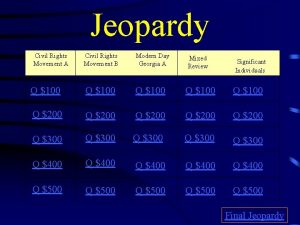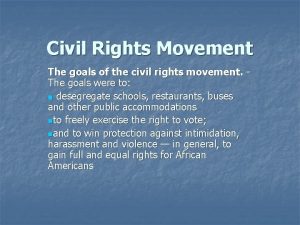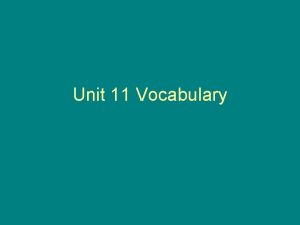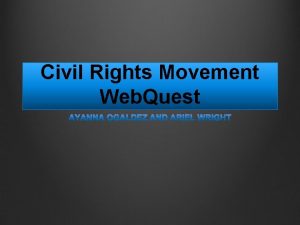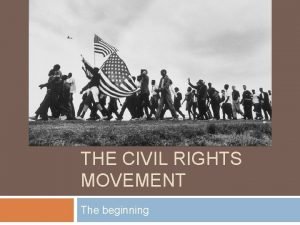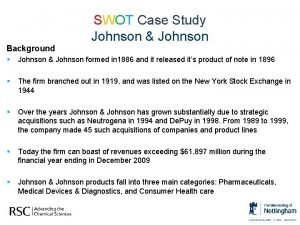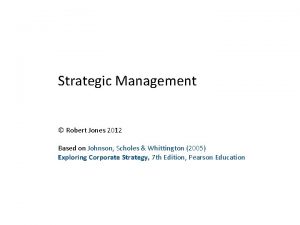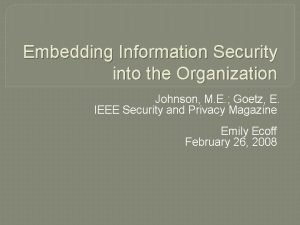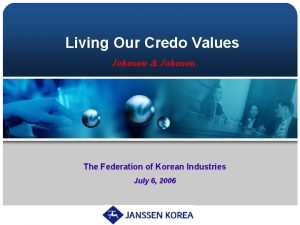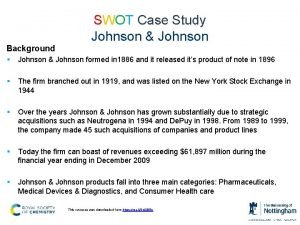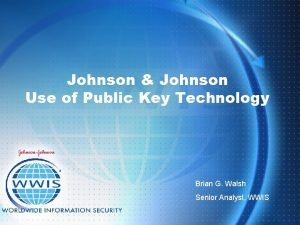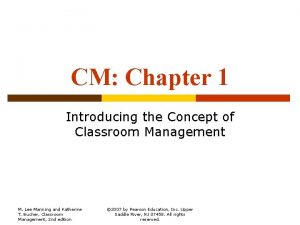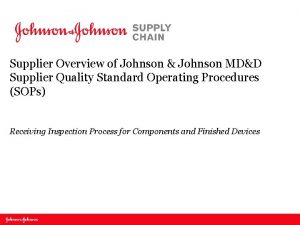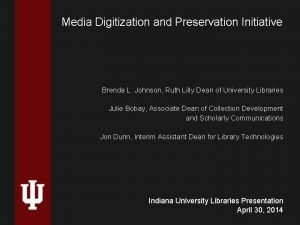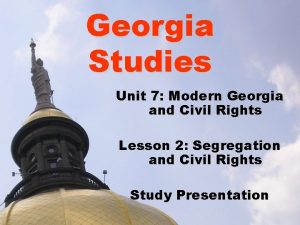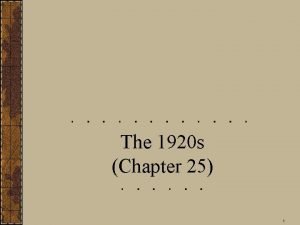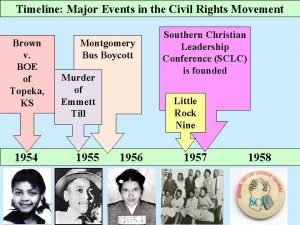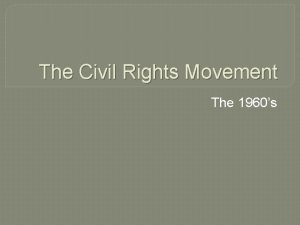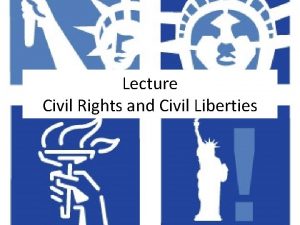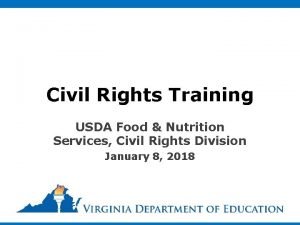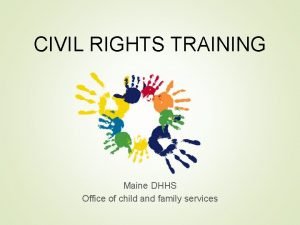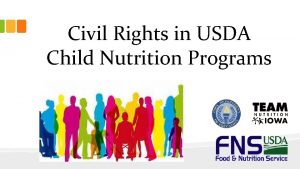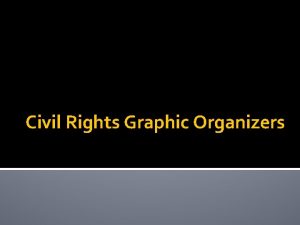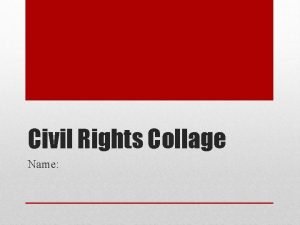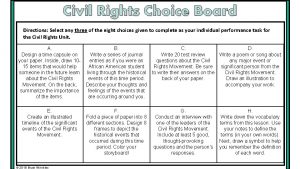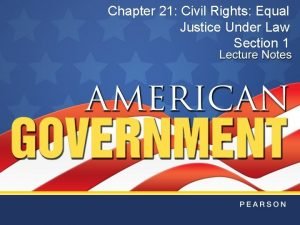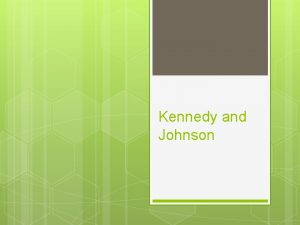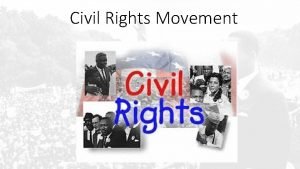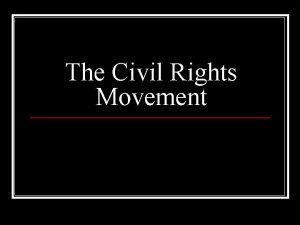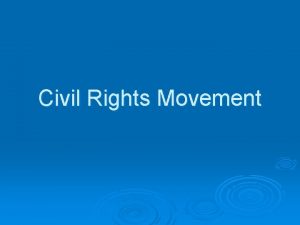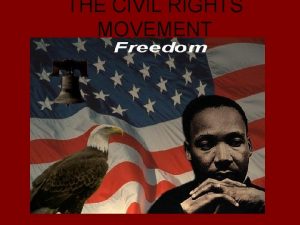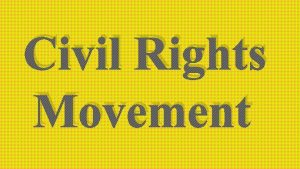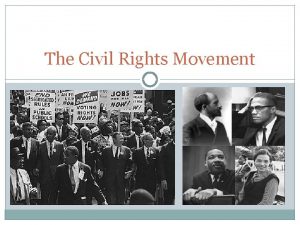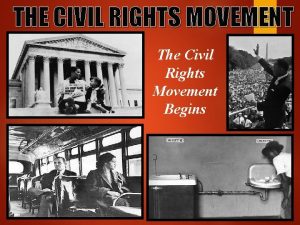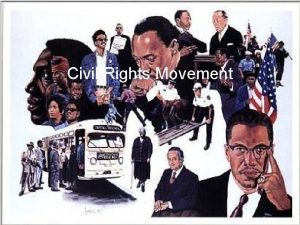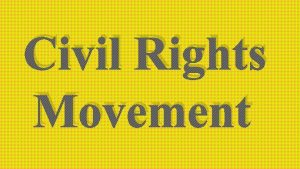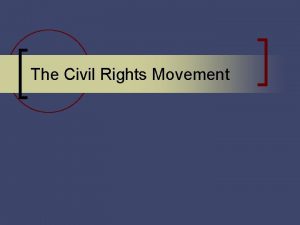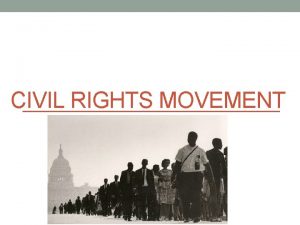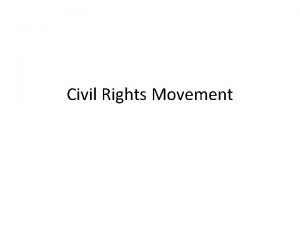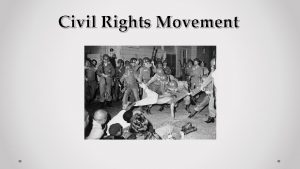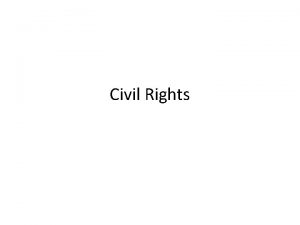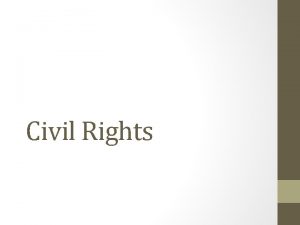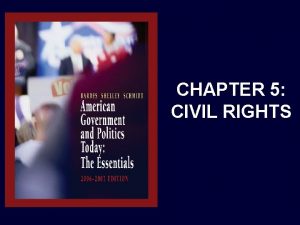The Civil Rights Movement The Kennedy and Johnson



































- Slides: 35

The Civil Rights Movement & The Kennedy and Johnson Years U. S History

De Jure Segregation / De Facto Segregation ¡ De Jure Segregation – Segregation by law; Southern states had enacted Jim Crow laws following the Civil War, supported by the Supreme Courts ruling in Plessy v. Ferguson (1896) that such laws were constitutional as long as facilities were “separate but equal. ” ¡ De Facto Segregation – Segregation by custom or tradition; Nationwide African-Americans were forced to follow “unwritten rules”, being denied housing, employment, and service in private businesses due to their race.

Jackie Robinson ¡ The first African American to play major league baseball; In 1947 Robinson joined the Brooklyn Dodgers, swearing to the team owner that for 2 years he would not respond publicly to racist attacks. Robinson braved death threats and physical & verbal abuse, but won the hearts of millions through his play on the field, opening the way for integration of all professional sports.

Closure Question #1: Why did the struggle for equal rights intensify after World War II? (At least 1 sentence) ¡ In many ways, World War II set the stage for the rise of the modern civil rights movement. President Roosevelt banned discrimination in defense industries in 1941. Gunnar Myrdal’s publication in 1944 of An American Dilemma brought the issue of American prejudice to the forefront of public consciousness. Lastly, after risking their lives defending freedom abroad, African Americans were unwilling to accept discrimination at home.

Brown v. Board of Education / Earl Warren ¡ Brown v. Board of Education (1954) – In a case argued by Thurgood Marshall of the NAACP, the Supreme court ruled that the concept of “separate but equal” was unconstitutional, leading to eventual integration. ¡ Earl Warren – Supreme Court Chief Justice during the Brown case, Warren wrote the court’s decision, stating “segregation of children by race… deprives children of the minority group of an equal education. ”

Closure Question #2: How did the Brown v. Board of Education decision lead to conflict between federal and state governments? (At least 1 sentence) ¡ ¡ ¡ The Brown decision was one of the most significant and controversial in American history. Because public education touched so many Americans, it had a much greater impact than cases involving only professional and graduate schools. Moreover, by overturning the principle of “separate but equal”, the Court lent its support to the views of many civil rights advocates that all forms of segregation were wrong. In a separate ruling, known as Brown II, the Court called for the implementation of its decision “with all deliberate speed” across the nation. However, most members of Congress endorsed “The Southern Manifesto. ” They pledged to oppose the Brown ruling through all “lawful means, ” on the grounds that the Court had misinterpreted the Constitution. Historically, education had been a state matter. States and local school boards ran the schools, and the federal government had little involvement. Local and state officials resisted the Brown decision’s order to desegregate, and clashes with the federal government resulted.

Civil Rights Act of 1957 ¡ Law establishing the United States Civil Rights Commission, which had the power to investigate violations of civil rights. Though in its early years the Commission did little to investigate and end discriminatory practices, the law is significant as the first Civil Rights bill passed by Congress since Reconstruction.

Closure Question #3: Why is the Montgomery bus boycott considered a turning point in the civil rights movement? (At least 1 sentence) Rosa Parks / Montgomery Bus Boycott ¡ Rosa Parks – An African American seamstress who, on December 1, 1955, refused to comply with a Montgomery, Alabama law requiring her to give up her seat on a city bus to a white passenger. Parks was arrested, sparking a chain of events leading to the Montgomery Bus Boycott. ¡ Montgomery Bus Boycott (1955 -1956) – Organized by civil rights leaders in Montgomery, including Martin Luther King Jr. , African Americans refused to ride the city buses in protest of city law. The loss of money by the city bus company combined with a ruling by the Supreme Court led the law to be overturned in late 1956.

Dr. Martin Luther King Jr. (1929 -1968) ¡ Southern Baptist minister who became the voice of the Civil Rights Movement in the late 1950 s and 1960 s; Inspired by Mohandas Gandhi, King led non-violent protests against segregation in the south and inspired Americans, both white and black, with his public speeches. King was assassinated in Memphis, Tennessee on April 4 th, 1968.

Closure Assignment #1 ¡ 1. 2. 3. Answer the following questions based on what you have learned from Chapter 27, Section 1: Why did the struggle for equal rights intensify after World War II? (At least 1 sentence) How did the Brown v. Board of Education decision lead to conflict between federal and state governments? (At least 1 sentence) Why is the Montgomery bus boycott considered a turning point in the civil rights movement? (At least 1 sentence)

Closure Question #1: Why were sit-ins often a successful tactic? (At least 1 sentence) Sit-In / Student Nonviolent Coordinating Committee ¡ Sit-In - Peaceful protest in which African Americans sat in white-only restaurants waiting to be served; On February 1, 1960 four African American students sat at a lunch counter in Greensboro, North Carolina, sparking a wave of similar protests across the southern United States. ¡ SNCC – Grass-roots student-organized civil rights group which organized peaceful protests during the 1960 s.

Closure Question #2: Why did the freedom rides lead to violence? (At least 1 sentence) “Freedom Ride” ¡ (Spring 1961) Two buses filled with African American protesters departed Washington D. C. to travel through the South to New Orleans. Along the way they challenged segregation laws, using whites only restrooms. In Alabama one of the busses was firebombed and a white mob attacked the riders, leading President Kennedy to take steps to protect the riders, officially desegregating interstate transportation.

March on Washington ¡ August 28, 1963 – More than 200, 000 civil rights protesters converged on the Lincoln Memorial in Washington D. C. The highlight of the protest was Martin Luther King Junior’s “I Have a Dream” speech, which was watched by millions of Americans nationwide on TV. The event is viewed as a major turning point in American public opinion regarding civil rights.

Filibuster / Civil Rights Act of 1964 ¡ Filibuster – Tactic by which senators give long speeches to hold up legislative business; In 1964 a group of Southern senators held up passage of the Civil Rights Act of 1964 for 80 days until supporters finally put together enough votes to overcome it. ¡ Civil Rights Act of 1964 – Banned segregation in public accommodations and gave the federal government the ability to compel schools to desegregate and prosecute individuals who violate people’s civil rights.

Closure Assignment #2 ¡ 1. 2. 3. Answer the following questions based on what you have learned from Chapter 27, Section 2: Why were sit-ins often a successful tactic? (At least 1 sentence) Why did the freedom rides lead to violence? (At least 1 sentence) What events led to passage of the Civil Rights Act of 1964? (List at least 3)

Closure Question #1: How did the Selma march help lead to the passage of civil rights legislation? (At least 1 sentence) Voting Rights Act / 24 th Amendment ¡ Voting Rights Act (1965) – Influenced by violence against protesters marching for voting rights in Selma, Alabama, Congress banned literacy tests and empowered the federal government to oversee voting registration and elections. ¡ 24 th Amendment (1964) – Banned Poll Taxes, which had been used to keep the poor and minorities from voting in many states.

Kerner Commission ¡ Established by President Johnson to investigate the causes of violence in the United States; The Commission concluded that racial discrimination was the single most important cause of violence and recommended establishing and expanding federal programs to overcome the problems of America’s ghettos.

Closure Question #2: How did Malcolm X’s views differ from Martin Luther King Jr. ’s views? (At least 2 sentences) Malcolm X (1925 -1965) / Nation of Islam ¡ Malcolm X (a. k. a. Malcolm Little) – The most well-known African American radical during the 1960 s; Following a troubled youth, Malcolm was arrested for burglary at age 21. While in prison he converted to the Nation of Islam, a religious sect headed by Elijah Muhammad. After his release from prison, Malcolm X became the most prominent minister of the Nation of Islam, demanding a strict separation of the races and advocating the use of violence by African Americans to gain their rights.

Black Power / Black Panthers ¡ Black Power – Movement begun by SNCC leader Stokely Carmichael in 1966 which called for African Americans to collectively use their economic and political muscle to gain equality, not simply peaceful protest. ¡ Black Panthers – Begun in Oakland, California in 1966, members of this militant African American group organized armed patrols of urban neighborhoods to protect people from police brutality. The Panther’s style appealed to many young African Americans during the 60 s and 70 s but led to violent confrontations with police.

Assassination of Dr. King ¡ (April 4, 1968) While staying in Memphis, Tennessee in support of a sanitation workers strike, Martin Luther King Jr. was shot on the balcony of his motel room. James Earl Ray, a white ex-convict, was charged and convicted for the murder. Hundreds or race riots broke out nationwide following news of King’s death.

Closure Question #3: Why did Justice Thurgood Marshall support affirmative action? (At least 1 sentence) ¡ ¡ The Nixon administration formally established affirmative action as a means of closing the economic gap between blacks and whites. In a short period of time, colleges and universities, businesses, and local and state governments followed the federal government’s lead and implemented their own affirmative action plans to increase African American representation in schools and the workforce. Affirmative action proved controversial from the start. Some whites argued that it constituted reverse discrimination and violated the goal of creating a colorblind society. Justice Thurgood Marshall disagreed. “Three hundred and fifty years ago, the Negro was dragged to this country in chains to be sold into slavery, ” Marshall wrote. “The position of the Negro today in America is the tragic but inevitable consequence of centuries of unequal treatment. ” Until the nation addressed the legacy of this unequal treatment, Marshall argued, it would not fulfill its promise of providing equal rights and opportunities for all. This debate, or controversy, as you will see in future events, remained unresolved.

Closure Assignment #3 ¡ 1. 2. 3. Answer the following questions based on what you have learned from Chapter 27, Section 3: How did the Selma march help lead to the passage of civil rights legislation? (At least 1 sentence) How did Malcolm X’s views differ from Martin Luther King Jr. ’s views? (At least 2 sentences) Why did Justice Thurgood Marshall support affirmative action? (At least 1 sentence)

John F. Kennedy / Richard Nixon ¡ John F. Kennedy – U. S. President from 1961 to 1963; A Democrat, JFK was the youngest President ever elected. A Harvard graduate from a prominent New England family (His father was US Ambassador to England during WWII), Kennedy won over the American people with his energy, charming personality, and model family, despite being a Catholic. ¡ Richard Nixon – Kennedy’s opponent in the 1960 election, Nixon later served as President from 1968 to 1974; Nixon came from a humble California family and, unlike Kennedy, had to work to support his family as a young man and believed in the Republican ideals of limiting government power, lowering taxes, and maintaining conservative values.

Closure Question #1: Television played an important role in the 1960 presidential election. How influential is television in presidential elections today. Explain in at least 1 sentence. ¡ ¡ The 1960 election highlighted the growing power and influence of television. The candidates agreed to four televised debates. During the campaign, Nixon was hospitalized with a knee infection. After getting out of the hospital, he committed himself to a gruel schedule of public appearances. By the time of the first debate, held in late September in Chicago and watched by about 70 million people, Nixon looked pale and exhausted. Nixon arrived at the television studio an hour early, but he refused the offer to have makeup applied to hide his newly-growing beard. By contrast, Kennedy, tanned from open-air campaigning in California, looked healthy and confident. His relaxed manner, easy charm, and quick sense of humor added to his appeal. In many ways, the debate boiled down to how the candidates looked and spoke, rather than what they said. Most Americans who listened to the debate on radio believed that Nixon had won. But the larger audience who watched the debate on television concluded that Kennedy was the clear victor. Although Nixon tried to change his image in later debates, he was unable to alter the country’s initial impression of him.

Fidel Castro / Bay of Pigs Invasion ¡ Fidel Castro – Revolutionary who overthrew dictator Fulgencio Batista in 1959 and established Cuba as a communist state. Initially, many Americans supported Castro due to the cruelty of the Batista regime; however, once Castro formed an official alliance with the U. S. S. R. in 1961 , the U. S. ended diplomatic relations, trade, and travel to Cuba. ¡ Bay of Pigs Invasion – (April 1961) 1, 400 Cuban exiles, trained and supplied by the CIA, landed on the south coast of Cuba with the intention of overthrowing Castro. Due to poor management the invasion ended in disaster, with 1, 100 killed or captured.

Closure Question #2: The flexible response policy increased the military budget. How do you think this affected the nuclear arms race? (At least 1 sentence) Flexible Response ¡ JFK’s military policy, which emphasized the importance of preparing the United States to fight any type of conflict. During the Kennedy administration, government funding for all military corps increased.

Peace Corps / Alliance for Progress ¡ Peace Corps – Program created by JFK through which American volunteers travel around the world to assist developing countries, improving foreign opinion of the United States. ¡ Alliance for Progress – JFK’s policy toward Latin America; Kennedy tried to resurrect Roosevelt’s Good Neighbor Policy by providing economic assistance to Latin America.

Cuban Missile Crisis ¡ (October, 1962) U. S. intelligence discovered that the Soviets were building nuclear missiles sites in Cuba, threatening major East Coast cities. Kennedy demanded the removal of the missiles, and approved a naval blockade of Cuba to prevent the Soviets from completing the bases. Behind the scenes, Kennedy promised to remove U. S. missiles in Turkey and Italy. After 6 tense days, the Soviets agreed to the compromise.

Closure Assignment #4 ¡ 1. 2. 3. Answer the following questions based on what you have learned from Chapter 28, Section 1: Television played an important role in the 1960 presidential election. How influential is television in presidential elections today. Explain in at least 1 sentence. The flexible response policy increased the military budget. How do you think this affected the nuclear arms race? (At least 1 sentence) How did the Cuban missile crisis affect public opinion about President Kennedy? (At least 1 sentence)

Nuclear Test Ban Treaty / Berlin Wall ¡ Nuclear Test Ban Treaty – (1963) The first nuclear-weapons agreement between the U. S. and U. S. S. R. ; Both sides agreed to end aboveground nuclear tests. ¡ Berlin Wall – Built by communist East Germany to separate democratic West Berlin from East Berlin, keeping democratic ideas out and east Germans in. The wall became a symbol of the reality of the two Germanys and the gulf between the communist East and the democratic West. Closure Question #1: Why did Kennedy consider foreign policy to be the most important issue of his administration? (At least 1 sentence)

“New Frontier” / Equal Pay Act ¡ “New Frontier” – Term to describe Kennedy’s proposals to improve the economy, education, healthcare, civil rights, and the space program. ¡ Equal Pay Act – (1963) Supported by Kennedy, this law requires that all workers be paid equal wages for equal work, regardless of race or gender. Closure Question #2: Why do you think Kennedy called his domestic program the New frontier? (At least 1 sentence)

Deficit Spending / “Space Race” ¡ Deficit Spending – The government practice of borrowing money in order to spend more than it received from taxes. Kennedy’s tax plan gave tax cuts to middle-class Americans while increasing the tax burden on wealthier citizens, jump -starting the economic growth of the late 1960 s. ¡ “Space Race” – Term used to describe the competition between the Soviet Union and the United States to develop technology to successfully land on the moon. Closure Question #3: Was Kennedy’s commitment to the space program an extension of the Cold War? Explain (At least 1 sentence. )

Assassination of President Kennedy ¡ (November 22, 1963) While riding in a motorcade on a campaign trip in Dallas, Texas, President Kennedy shot and pronounced dead a half-hour later. Lee Harvey Oswald, a communist sympathizer who supported Fidel Castro & married a Russian woman, was arrested as the accused assassin. 2 days later, while being transferred between prisons, Oswald was shot and killed by Jack Ruby, a man with connections to a Chicago mafia. Kennedy’s assassination inspired the American government to fully support his policies. It also signaled a loss of innocence for many in the Baby Boom generation.

Warren Commission ¡ Special committee organized by the Supreme Court to conduct the official investigation of the assassination of President Kennedy. Despite multiple conspiracy theories and some contradictory evidence, the Commission concluded that Lee Harvey Oswald was the “lone killer”.

Closure Assignment #5 ¡ 1. 2. 3. Answer the following questions based on what you have learned from Chapter 28, Section 2: Why did Kennedy consider foreign policy to be the most important issue of his administration? (At least 1 sentence) Why do you think Kennedy called his domestic program the New frontier? (At least 1 sentence) Was Kennedy’s commitment to the space program an extension of the Cold War? Explain in at least 1 sentence.
 Civil rights and civil liberties webquest
Civil rights and civil liberties webquest Rosa parks mother
Rosa parks mother Civil rights movement jeopardy
Civil rights movement jeopardy Civil rights movement goal
Civil rights movement goal Civil rights movement vocabulary
Civil rights movement vocabulary Civil rights movement webquest
Civil rights movement webquest The civil rights movement
The civil rights movement Civil rights movement essential questions
Civil rights movement essential questions Swot of johnson and johnson
Swot of johnson and johnson Johnson and johnson bcg matrix
Johnson and johnson bcg matrix Johnson and johnson organizational structure
Johnson and johnson organizational structure Johnson and johnson values
Johnson and johnson values Understanding the mirai botnet
Understanding the mirai botnet Johnson and johnson swot
Johnson and johnson swot Jjeds johnson and johnson
Jjeds johnson and johnson Johnson and johnson three c's of classroom management
Johnson and johnson three c's of classroom management Johnson and johnson md&d
Johnson and johnson md&d Brad and laurie johnson
Brad and laurie johnson La raza apush
La raza apush Unit 7 modern ga and civil rights
Unit 7 modern ga and civil rights Chapter 14 postwar prosperity and civil rights
Chapter 14 postwar prosperity and civil rights Negative rights vs positive rights
Negative rights vs positive rights Duties towards self
Duties towards self Legal rights and moral rights
Legal rights and moral rights Negative right
Negative right Civil rights timeline of events
Civil rights timeline of events Civil rights sitins
Civil rights sitins Right to die
Right to die Usda civil rights training
Usda civil rights training Civil rights training child nutrition programs
Civil rights training child nutrition programs Civil rights in child nutrition programs
Civil rights in child nutrition programs Civil rights graphic organizer
Civil rights graphic organizer Civil rights collage
Civil rights collage Civil rights choice board
Civil rights choice board Chapter 21 civil rights equal justice under law
Chapter 21 civil rights equal justice under law Chapter 20 civil liberties protecting individual rights
Chapter 20 civil liberties protecting individual rights


